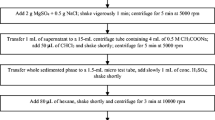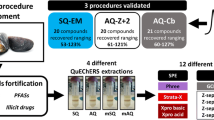Abstract
The objective of this work was to study the effects of washing and purification steps on qualitative and quantitative analysis of fecal stanols in the oyster Crassostrea gigas using either single or a combination of lipid purification steps on silica gel or aminopropyl bonded silica gel (NH2) or a washing step. Among the three analytical pathways compared, the two including water extraction or NH2 purification did not lead to higher recoveries and decreased repeatabilities of extractions compared to the single purification on silica gel. This latter led to similar recoveries (ca. 80 %) and repeatabilities (ca. 10 %) for both spiked standards (coprostanol and sitostanol). This analytical pathway has been applied to oysters collected in a harvesting area in Brittany (France) where fecal contaminations are important and allowed to quantify eight stanols in oysters. The relative proportions of fecal stanols of these oysters were combined with principal component analysis in order to investigate the usefulness of their stanol fingerprints to record a fecal contamination and to distinguish its source between human, porcine and bovine contaminations. Oysters non-fecally contaminated by Escherichia coli did not present specific stanol fingerprints while oysters fecally contaminated had a bovine fingerprint, suggesting a contamination of these samples by bovine sources. As a consequence, the method developed here allows the use of stanol fingerprints of oysters as a microbial source tracking tool that can be applied to shellfish harvesting areas subjected to fecal contaminations in order to identify the different sources of contamination and improve watershed management.





Similar content being viewed by others
Abbreviations
- BSTFA:
-
N,O-bis-(trimethylsilyl)trifluoroacetamide
- DCM:
-
Dichloromethane
- DW:
-
Dry weight
- GC–MS:
-
Gas chromatography–mass spectrometry
- MeOH:
-
Methanol
- NH2 :
-
Aminopropyl-bonded silica gel
- PCA:
-
Principal component analysis
- TMCS:
-
Trimethylchlorosilane
References
Fong T–T, Lipp EK (2005) Enteric viruses of humans and animals in aquatic environments: health risks, detection, and potential water quality assessment tools. Microbiol Mol Biol Rev 69:357–371. doi:10.1128/MMBR.69.2.357-371.2005
Hundesa A, Maluquer de Motes C, Bofill-Mas S et al (2006) Identification of human and animal adenoviruses and polyomaviruses for determination of sources of fecal contamination in the environment. Appl Environ Microbiol 72:7886–7893. doi:10.1128/AEM.01090-06
Soller J, Embrey M, Tuhela L et al (2010) Risk-based evaluation of Escherichia coli monitoring data from undisinfected drinking water. J Environ Manag 91:2329–2335. doi:10.1016/j.jenvman.2010.06.017
Zatta P, Gobbo S, Rocco P et al (1992) Evaluation of heavy metal pollution in the Venetian lagoon by using Mytilus galloprovincialis as biological indicator. Sci Total Environ 119:29–41. doi:10.1016/0048-9697(92)90253-O
Baudrimont M, Schäfer J, Marie V et al (2005) Geochemical survey and metal bioaccumulation of three bivalve species (Crassostrea gigas, Cerastoderma edule and Ruditapes philippinarum) in the Nord Médoc salt marshes (Gironde estuary, France). Sci Total Environ 337:265–280
Goulletquer P, Le Moine O (2002) Shellfish farming and coastal zone management (CZM) development in the Marennes-Oleron Bay and Charentais Sounds (Charente Maritime, France): a review of recent developments. Aquac Int 10:507–525. doi:10.1023/A:1023975418669
Mieszkin S, Caprais MP, Le Mennec C et al (2013) Identification of the origin of fecal contamination in estuarine oysters using Bacteroidales and F-specific RNA bacteriophage markers. J Appl Microbiol 115:897–907. doi:10.1111/jam.12260
Simpson JM, Santo Domingo JW, Reasoner DJ (2002) Microbial source tracking: state of the science. Environ Sci Technol 36:5279–5288. doi:10.1021/es026000b
Glassmeyer ST, Furlong ET, Kolpin DW et al (2005) Transport of chemical and microbial compounds from known wastewater discharges: potential for use as indicators of human fecal contamination. Environ Sci Technol 39:5157–5169. doi:10.1021/es048120k
Cimenti M, Hubberstey A, Bewtra J, Biswas N (2007) Alternative methods in tracking sources of microbial contamination in waters. Water SA 33:183–194
Field KG, Samadpour M (2007) Fecal source tracking, the indicator paradigm, and managing water quality. Water Res 41:3517–3538. doi:10.1016/j.watres.2007.06.056
Jardé E, Gruau G, Mansuy-Huault L et al (2006) Using sterols to detect pig slurry contribution to soil organic matter. Water Air Soil Pollut 178:169–178. doi:10.1007/s11270-006-9188-9
Ahmad F, Tourlousse DM, Stedtfeld RD et al (2009) Detection and occurence of indicator organisms and pathogens. Water Environ Res 81:959–980. doi:10.2175/106143009X12445568399299
Derrien M, Jardé E, Gruau G et al (2012) Origin of fecal contamination in waters from contrasted areas: stanols as microbial source tracking markers. Water Res 46:4009–4016. doi:10.1016/j.watres.2012.05.003
Biache C, Philp RP (2013) The use of sterol distributions combined with compound specific isotope analyses as a tool to identify the origin of fecal contamination in rivers. Water Res 47:1201–1208. doi:10.1016/j.watres.2012.11.037
Chan K-H, Lam MHW, Poon K-F et al (1998) Application of sedimentary fecal stanols and sterols in tracing sewage pollution in coastal waters. Water Res 32:225–235. doi:10.1016/S0043-1354(97)00175-9
Leeming R, Ball A, Ashbolt N, Nichols P (1996) Using fecal sterols from humans and animals to distinguish fecal pollution in receiving waters. Water Res 30:2893–2900. doi:10.1016/S0043-1354(96)00011-5
Bull ID, Lockheart MJ, Elhmmali MM et al (2002) The origin of faeces by means of biomarker detection. Environ Int 27:647–654. doi:10.1016/S0160-4120(01)00124-6
Tyagi P, Edwards DR, Coyne MS (2009) Distinguishing between human and animal sources of fecal pollution in waters: a review. Int J Water 5:15. doi:10.1504/IJW.2009.023080
Gourmelon M, Caprais MP, Le Mennec C et al (2010) Application of library-independent microbial source tracking methods for identifying the sources of fecal contamination in coastal areas. Water Sci Technol 61:1401. doi:10.2166/wst.2010.033
Shah VG, Dunstan RH, Geary PM et al (2007) Evaluating potential applications of fecal sterols in distinguishing sources of fecal contamination from mixed fecal samples. Water Res 41:3691–3700. doi:10.1016/j.watres.2007.04.006
Derrien M, Jarde E, Gruau G, Pierson-Wickmann A-C (2011) Extreme variability of steroid profiles in cow feces and pig slurries at the regional scale: implications for the use of steroids to specify fecal pollution sources in waters. J Agric Food Chem 59:7294–7302. doi:10.1021/jf201040v
Water National Agency of Loire-Brittany. (accessed Jan. 2014). http://www.eau-loire-bretagne.fr/informations_et_donnees/reseaux_de_mesure
Solecki O, Jeanneau L, Jardé E et al (2011) Persistence of microbial and chemical pig manure markers as compared to fecal indicator bacteria survival in freshwater and seawater microcosms. Water Res 45:4623–4633. doi:10.1016/j.watres.2011.06.012
Jeanneau L, Solecki O, Wéry N et al (2012) Relative decay of fecal indicator bacteria and human-associated markers: a microcosm study simulating wastewater input into seawater and freshwater. Environ Sci Technol 46:2375–2382. doi:10.1021/es203019y
Sherwin MR, Van Vleet ES, Fossato VU, Dolci F (1993) Coprostanol (5β-cholestan-3β-ol) in lagoonal sediments and mussels of Venice, Italy. Mar Pollut Bull 26:501–507. doi:10.1016/0025-326X(93)90467-X
Cathum S, Sabik H (2001) Determination of steroids and coprostanol in surface water, effluent and mussel using gas chromatography–mass spectrometry. Chromatographia 53:S394–S399. doi:10.1007/BF02490364
Gagné F, Blaise C, Aoyama I et al (2002) Biomarker study of a municipal effluent dispersion plume in two species of freshwater mussels. Environ Toxicol 17:149–159. doi:10.1002/tox.10046
Gagné F, Blaise C, Lachance B et al (2001) Evidence of coprostanol estrogenicity to the freshwater mussel Elliptio complanata. Environ Pollut 115:97–106. doi:10.1016/S0269-7491(01)00089-6
Hellou J, Yeats P, Steller S, Gagné F (2003) Chemical contaminants and biological indicators of mussel health during gametogenesis. Environ Toxicol Chem 22:2080. doi:10.1897/02-396
Yeats P, Gagné F, Hellou J (2008) Body burden of contaminants and biological effects in mussels: an integrated approach. Environ Int 34:254–264. doi:10.1016/j.envint.2007.08.009
Linehan L, O’Connor T, Burnell G (1999) Seasonal variation in the chemical composition and fatty acid profile of Pacific oysters (Crassostrea gigas). Food Chem 64:211–214. doi:10.1016/S0308-8146(98)00144-7
Costil K, Royer J, Ropert M et al (2005) Spatio-temporal variations in biological performances and summer mortality of the Pacific oyster Crassostrea gigas in Normandy (France). Helgol Mar Res 59:286–300. doi:10.1007/s10152-005-0004-5
Danger M, Allard B, Arnous M et al (2012) Effects of food-web structure on the quantity and the elemental quality of sedimenting material in shallow lakes. Hydrobiologia 679:251–266. doi:10.1007/s10750-011-0890-2
Guenet B, Danger M, Harrault L et al (2014) Fast mineralization of land-born C in inland waters: first experimental evidences of aquatic priming effect. Hydrobiologia 721:35–44. doi:10.1007/s10750-013-1635-1
Lacaze J-PCL, Stobo LA, Turrell EA, Quilliam MA (2007) Solid-phase extraction and liquid chromatography–mass spectrometry for the determination of free fatty acids in shellfish. J Chromatogr A 1145:51–57. doi:10.1016/j.chroma.2007.01.053
Pernet F, Pelletier CJ, Milley J (2006) Comparison of three solid-phase extraction methods for fatty acid analysis of lipid fractions in tissues of marine bivalves. J Chromatogr A 1137:127–137. doi:10.1016/j.chroma.2006.10.059
French Ministry of Agriculture, Agri-food and Forests. http://www.acces.agriculture.gouv.fr/cartostat/#v=map2;i=stru1.saumoy10;l=fr (accessed Jan. 2014)
Jeanneau L, Jardé E, Gruau G (2011) Influence of salinity and natural organic matter on the solid phase extraction of sterols and stanols: application to the determination of the human sterol fingerprint in aqueous matrices. J Chromatogr A 1218:2513–2520. doi:10.1016/j.chroma.2011.02.066
Landgraf D, Leinweber P, Makeschin F (2006) Cold and hot water-extractable organic matter as indicators of litter decomposition in forest soils. J Plant Nutr Soil Sci 169:76–82. doi:10.1002/jpin.200521711
Dupont J, Dumont F, Menanteau C, Pommepuy M (2004) Calibration of the impedance method for rapid quantitative estimation of Escherichia coli in live marine bivalve molluscs. J Appl Microbiol 96:894–902. doi:10.1111/j.1365-2672.2004.02218.x
Gordon DT, Collins N (1982) Anatomical distribution of sterols in oysters (Crassostrea gigas). Lipids 17:811–817. doi:10.1007/BF02535358
Dunstan GA, Volkman JK, Barrett SM (1993) The effect of lyophilization on the solvent extraction of lipid classes, fatty acids and sterols from the oyster Crassostrea gigas. Lipids 28:937–944. doi:10.1007/BF02537504
Knauer J, Kerr RG, Lindley D, Southgate PC (1998) Sterol metabolism of Pacific oyster (Crassostrea gigas) spat. Comp Biochem Physiol Part B Biochem Mol Biol 119:81–84. doi:10.1016/S0305-0491(97)00269-1
Nishimura M, Koyama T (1977) The occurrence of stanols in various living organisms and the behavior of sterols in contemporary sediments. Geochim Cosmochim Acta 41:379–385. doi:10.1016/0016-7037(77)90265-4
Volkman JK (2003) Sterols in microorganisms. Appl Microbiol Biotechnol 60:495–506. doi:10.1007/s00253-002-1172-8
Harris JM (1993) The presence, nature, and role of gut microflora in aquatic invertebrates—a synthesis. Microb Ecol 25:195–231
Berenberg CJ, Patterson GW (1981) The relationship between dietary phytosterols and the sterols of wild and cultivated oysters. Lipids 16:276–278. doi:10.1007/BF02535028
Acknowledgments
As a part of the Riskmanche project (http://www.brighton.ac.uk/riskmanche/), this study was fully funded by the Interreg IV A France (Channel)—England cross-border European cooperation programme. We thank the Laboratoire National de Référence for analyses of E. coli, Mr. Pascal Blanchard for oyster supply, colleagues from the Laboratoire Santé Environnement et Microbiologie (IFREMER, Plouzané, France) for oyster sampling and Dr. Justine Jaguin for her graphical help.
Author information
Authors and Affiliations
Corresponding author
About this article
Cite this article
Harrault, L., Jardé, E., Jeanneau, L. et al. Development of the Analysis of Fecal Stanols in the Oyster Crassostrea gigas and Identification of Fecal Contamination in Shellfish Harvesting Areas. Lipids 49, 597–607 (2014). https://doi.org/10.1007/s11745-014-3908-5
Received:
Accepted:
Published:
Issue Date:
DOI: https://doi.org/10.1007/s11745-014-3908-5




